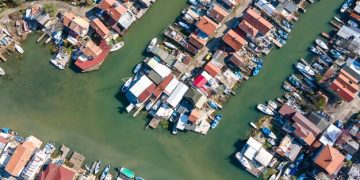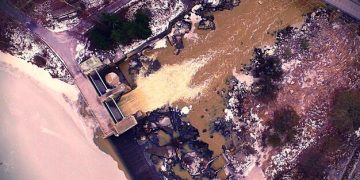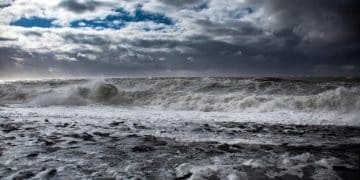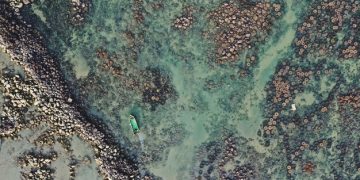Ocean Acidification: US Shellfish Decline by 2030?
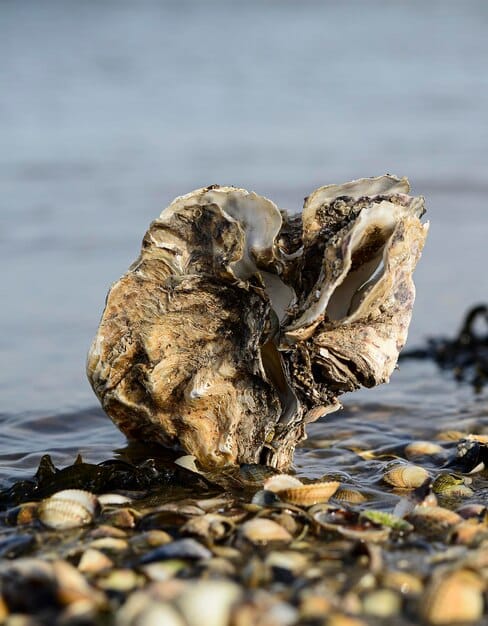
Projections suggest a significant decline, potentially ranging from 25% to over 50% in some regions, for U.S. shellfish populations by 2030 due to ocean acidification, severely impacting ecosystems and valuable aquatic industries.
The silent chemistry of our oceans is undergoing a profound transformation, raising critical questions about the future of marine life. One particularly urgent concern revolves around the question: Ocean Acidification: What परसेंटेज Decline in US Shellfish Populations is Expected by 2030? This isn’t merely an ecological issue; it carries significant economic and cultural ramifications for coastal communities across the United States. Understanding the scale of this projected decline requires diving into complex scientific models, real-world observations, and the interconnectedness of marine ecosystems.
Understanding Ocean Acidification: The Core Threat
Ocean acidification, often termed “the other CO2 problem,” refers to the ongoing decrease in the pH of the Earth’s oceans, caused by the uptake of atmospheric carbon dioxide (CO2). As human activities, primarily the burning of fossil fuels, release vast amounts of CO2 into the atmosphere, a significant portion dissolves into the ocean. This process triggers a series of chemical reactions, leading to an increase in hydrogen ions and a decrease in carbonate ions, both of which are vital for marine life.
For organisms that build shells and skeletons, such as shellfish, corals, and some plankton, the reduction in available carbonate ions is particularly problematic. These animals rely on carbonate to form calcium carbonate, the fundamental building block of their protective structures. As ocean acidity rises, the water becomes more corrosive, making it harder for these organisms to build and maintain their shells, and in severe cases, causing existing shells to dissolve.
The Chemistry Behind the Crisis
The chemical reactions are straightforward yet devastating. When CO2 dissolves in seawater, it forms carbonic acid (H2CO3). This acid then dissociates into hydrogen ions (H+) and bicarbonate ions (HCO3-). The increase in H+ ions lowers the pH of the ocean, making it more acidic. Crucially, these excess H+ ions also react with carbonate ions (CO32-), forming more bicarbonate, effectively reducing the concentration of the very carbonate ions that calcifying organisms need.
This subtle shift in ocean chemistry has cascading effects throughout the marine food web. Organisms at the base, like pteropods (tiny sea snails vital to many ocean ecosystems), are highly susceptible. Their weakening shells can disrupt food chains, directly impacting fish, birds, and marine mammals that rely on them for sustenance. The impact isn’t uniform; coastal regions, estuaries, and upwelling zones can experience more rapid and severe changes due to additional local stressors like nutrient runoff.
- pH Decrease: The ocean’s average pH has already dropped from 8.2 to 8.1 since the Industrial Revolution.
- Carbonate Saturation: Waters are becoming undersaturated with aragonite and calcite, forms of calcium carbonate.
- Rate of Change: The current rate of acidification is unprecedented in at least 300 million years, giving marine life little time to adapt.
- Regional Variability: Impacts are amplified in cold water regions and coastal areas influenced by riverine input.
Understanding these fundamental chemical changes is crucial to grasping the magnitude of the threat. The alterations are not localized but affect the entire global ocean, jeopardizing a vast array of marine biodiversity and the critical ecosystem services they provide. This chemical transformation sets the stage for the specific threats faced by U.S. shellfish populations.
Shellfish at Risk: Why Are They So Vulnerable?
Shellfish, including oysters, clams, mussels, and scallops, are particularly vulnerable to ocean acidification due to their reliance on calcium carbonate to build their shells. These commercially valuable species are often referred to as “ecosystem engineers” because they filter water, create habitats, and serve as a crucial food source for many species, including humans. Their sensitivity to changes in ocean chemistry makes them an early warning sign for broader ecosystem health.
The life cycle of shellfish presents multiple points of vulnerability. During their larval stages, these organisms are highly development-dependent on precise environmental conditions, including seawater chemistry. Larvae are often unable to properly form their initial shells in acidic waters, leading to high mortality rates. Even if they survive to adulthood, the energetic cost of maintaining shells in corrosive conditions can divert resources away from growth and reproduction, ultimately leading to smaller, weaker, and less prolific populations.
Impacts Across Life Stages
- Larval Development: Shell formation is critical in early life; increased acidity makes this process energetically costly or impossible.
- Growth and Maintenance: Adult shellfish must expend more energy to repair and maintain their shells, diverting energy from growth, reproduction, and immune function.
- Reproduction: Decreased energy reserves can lead to reduced reproductive output and smaller, less viable offspring.
- Predator Defense: Weaker shells offer less protection against predators, increasing mortality rates.
The challenges extend beyond direct physiological impacts. Acidification can alter the behavior of shellfish, their ability to find food, and their interactions with other species. For instance, some studies suggest that altered water chemistry can impair the ability of oysters to cement themselves to surfaces, potentially impacting their survival in turbulent environments. These subtle, often overlooked, effects combine to create a formidable challenge for maintaining healthy shellfish populations.
Different species within the shellfish category exhibit varying degrees of sensitivity. Oysters, especially the Pacific oyster, have shown acute vulnerability in aquaculture settings. Clams also demonstrate significant susceptibility, while mussels might be slightly more resilient but still impacted. This variability complicates predictions and emphasizes the need for species-specific research to truly understand the regional nuances of decline.
Ultimately, the vulnerability of shellfish stems from a fundamental biological dependency. Their very architecture, evolved over millions of years in a more stable ocean chemistry, makes them exquisitely sensitive to the rapid changes now underway. This sensitivity places them firmly at the forefront of organisms facing direct and immediate threats from ocean acidification.
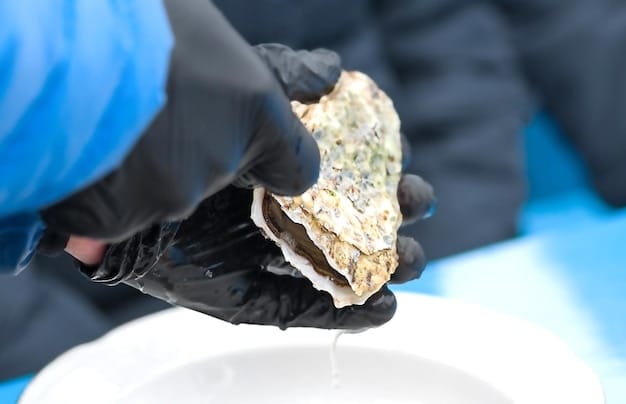
Projected Decline: What the Science Says for US Shellfish by 2030
Forecasting the precise percentage decline in U.S. shellfish populations by 2030 is a complex scientific endeavor, synthesizing data from predictive models, laboratory experiments, and long-term field observations. While exact figures vary depending on species, region, and modeling assumptions, the scientific consensus points towards significant and concerning reductions if current trends continue. Projections often hover around a 25-50% decline in productivity or population size for susceptible species in key areas within the next decade.
For instance, in the Pacific Northwest, where upwelling brings naturally lower pH waters closer to the surface, the oyster industry has already faced substantial challenges. Hatcheries reliant on stable water conditions have implemented costly mitigation strategies, but wild populations remain highly vulnerable. Scientists in this region have warned of declines in specific oyster and clam species productivity by 25-40% or more by the mid-2030s under certain emissions scenarios.
Regional Outlooks and Specific Vulnerabilities
The vulnerability is not uniform across the U.S. coastline:
- Pacific Northwest: Already seeing direct impacts. Projections range from 25% to over 50% decline in oyster and clam productivity within specific vulnerable areas by 2030 without significant intervention.
- Northeastern US: Shellfish like clams and mussels are critical here. While perhaps less immediately impacted than the Pacific, models predict significant stress on shell growth and survival, potentially leading to a 30-40% reduction in harvestable biomass for some species over the next two decades.
- Gulf of Mexico & Southeastern US: Oysters are paramount. These regions face acidification compounded by freshwater runoff and local pollution. Estimates suggest a 20-30% reduction in oyster reef health and productivity is plausible by 2030 in certain hotspots.
- Alaska: Cold, productive waters are particularly susceptible to rapid acidification. Alaskan king crab and other crustacean larvae are showing high sensitivity, with potential for substantial fishery impacts. Alaska’s situation highlights that crustaceans, not just mollusks, are at risk.
These figures are often presented as “production declines” or “biomass reductions,” which directly correlate to population health and available fishery yields. It’s important to note that these are conservative estimates, often not accounting for compounding stressors like warming waters, hypoxia (low oxygen zones), and pollution, which frequently exacerbate the effects of acidification. Real-world conditions could lead to even more severe outcomes.
The uncertainties in these projections largely stem from the complexity of marine ecosystems and the varied responses of different shellfish species. However, the consistent theme across all scientific assessments is that “no action” is not an option; significant decline is highly probable, profoundly impacting marine ecosystems and coastal economies.
Economic and Societal Impacts on US Coastal Communities
The potential decline in U.S. shellfish populations by 2030 due to ocean acidification is not merely an environmental concern; it presents a grave economic and societal threat to coastal communities. Shellfish aquaculture and wild fisheries support thousands of jobs, from harvesters and processors to distributors and restaurateurs. The industry contributes billions of dollars annually to the U.S. economy, and any significant reduction in yields would have far-reaching consequences.
For many small-scale fishing families and businesses, shellfish farming represents a primary, often generational, source of income. A decline in productivity translates directly into lost revenue, job displacement, and increased economic hardship. This impact is disproportionately felt in rural coastal communities where alternative employment opportunities may be scarce. The loss of a stable income stream can lead to out-migration, weakening the social fabric of these towns.
Ripple Effects Through the Economy
- Job Losses: Direct impacts on oyster farmers, clam diggers, processing plant workers, and related industries.
- Reduced Revenue: Decreased sales for fisheries, aquaculture operations, and seafood restaurants.
- Higher Seafood Prices: Scarcity could drive up prices for consumers, making shellfish a luxury item.
- Tourism Impacts: Coastal areas known for their fresh local seafood may see a decline in tourism if supplies dwindle.
- Cultural Loss: Many coastal traditions and festivals revolve around shellfish, their decline would erode local identity.
Beyond direct economic losses, there are broader societal implications. Shellfish are a culturally significant food source in many regions, deeply embedded in local culinary traditions and community events. Their decline could lead to a loss of heritage and identity for these communities. Furthermore, decreased availability of local, sustainable seafood could impact food security, particularly for vulnerable populations.
The economic models attempting to quantify these impacts often project losses in the hundreds of millions to billions of dollars annually. For example, a significant decline in the Pacific oyster industry alone could cost the region tens of millions of dollars annually, directly impacting local government through reduced tax revenues. The cumulative effects across all affected shellfish industries nationwide are staggering.
Consider the cascading effects: If wild mollusk populations dwindle, the ecosystems they support also suffer. Shellfish filter water, contributing to cleaner bays and estuaries. Their reefs provide habitat for fish and other marine life. The loss of these ecosystem services has its own economic value, impacting other fisheries and even real estate values in coastal areas. Addressing ocean acidification is thus not just about environmental stewardship but about safeguarding the economic vitality and social well-being of America’s coastal communities.
Mitigation and Adaptation Strategies: Hope for Shellfish?
Despite the grim projections, scientists, industry leaders, and policymakers are actively exploring and implementing mitigation and adaptation strategies to protect U.S. shellfish populations from ocean acidification. Mitigation primarily involves reducing the root cause—global carbon dioxide emissions—while adaptation focuses on helping organisms and industries cope with existing and projected changes.
Tackling global CO2 emissions is the most fundamental mitigation strategy. This requires a systemic shift towards renewable energy sources, enhanced energy efficiency, and carbon sequestration technologies. International agreements and national policies aimed at limiting greenhouse gas emissions are crucial, as is widespread public awareness and behavioral change. While this is a long-term solution, immediate and sustained action is vital to slow the rate of ocean acidification.
Local Adaptations and Innovations
At regional and local levels, adaptation strategies are gaining traction:
- Water Quality Management: Reducing local stressors like nutrient runoff from agriculture and wastewater can significantly alleviate the severity of acidification. Excess nutrients can lead to algal blooms, and their decomposition consumes oxygen and releases CO2, exacerbating local acidification. Improved wastewater treatment and agricultural best practices are key.
- Genetic Selection and Breeding: Scientists are working to identify and breed shellfish strains that exhibit greater resilience to acidic conditions. Some individual shellfish naturally possess genes that confer better tolerance, offering a pathway for developing more robust aquaculture stocks.
- Restoration Efforts: Restoring and creating shellfish reefs can help buffer local waters. Oysters, for example, can filter water and some research suggests their shells can slightly increase alkalinity in localized areas, providing a small, but important, localized benefit.
- Monitoring and Early Warning Systems: Deploying sensors to continuously monitor ocean pH and carbonate chemistry allows hatcheries and farms to adapt their operations. For instance, farmers can delay putting out larvae or move them to less acidic waters during peak vulnerability periods.
- Aquaculture Innovations: Developing new hatchery techniques and growing methods that either buffer water pH or provide optimal conditions for early life stages are crucial. This includes using shell hash or other materials to increase local alkalinity. Some hatcheries are filtering and treating incoming seawater to ensure suitable chemistry for larval growth.
Collaboration among scientists, industry, and government is essential for successful implementation of these strategies. Research is continually uncovering new insights, refining models, and developing innovative solutions. The path forward involves a multi-pronged approach, combining global efforts to curb CO2 with targeted, localized initiatives to build resilience in shellfish populations and the industries that depend on them.
These efforts offer a glimmer of hope, but their effectiveness will heavily depend on the speed and scale of implementation. While some decline by 2030 appears inevitable given the lagging nature of ocean chemistry response, aggressive mitigation and adaptation could lessen the long-term impact and ensure the continued viability of shellfish fisheries and aquaculture.

The Role of Policy and Science in Protecting Marine Resources
Effective policy and robust scientific inquiry are indispensable in the arduous task of protecting marine resources, especially in the face of complex challenges like ocean acidification. Without informed governmental action and continuous research, the projected declines in U.S. shellfish populations by 2030 could become even more severe, threatening both ecological stability and economic prosperity.
Policy frameworks at federal, state, and local levels play a critical role in managing carbon emissions, regulating local water quality, and funding research and adaptation efforts. Federally, initiatives like the Ocean Acidification Research and Monitoring Act (OAR Act) have been instrumental in establishing monitoring networks and supporting research. State-level policies, particularly in highly impacted regions like Washington and Oregon, have focused on specific programs to help shellfish growers and implement local water quality improvements.
Key Policy and Scientific Actions
- Funding Research & Monitoring: Sustained investment in scientific research to better understand ocean acidification’s impacts, develop resilient species, and refine predictive models.
- Carbon Emission Reduction Targets: Establishment and enforcement of ambitious national and international targets for greenhouse gas reductions.
- Water Quality Regulations: Strict regulations on nutrient and pollutant runoff to reduce local stressors that exacerbate acidification.
- Fisheries Management: Adaptive management plans for shellfish fisheries that consider ocean acidification impacts alongside other stressors.
- International Collaboration: Working with other nations to address the global nature of CO2 emissions and ocean acidification.
Science provides the foundational knowledge upon which effective policies are built. Researchers are not only quantifying the impacts of acidification but also identifying physiological mechanisms of resilience, developing tools for real-time monitoring, and pioneering genetic solutions. Breakthroughs in understanding how different species cope, or fail to cope, with changing pH are vital for targeted interventions.
Furthermore, scientists are playing an increasingly important role in communicating the urgency and complexity of ocean acidification to policymakers and the public. Translating intricate scientific findings into actionable recommendations and understandable narratives is crucial for fostering collective support and driving necessary changes. This collaborative effort transforms data into informed decisions that can safeguard marine ecosystems.
The synergy between policy and science is nowhere more apparent than in areas where acidification is already directly challenging the shellfish industry. Policymakers, responding to scientific warnings and industry concerns, have enacted measures such as allowing aquaculture operations to temporarily move seed to buffered waters or investing in research into more resilient shellfish strains. This adaptive governance, informed by cutting-edge science, represents the best hope for mitigating severe impacts on U.S. shellfish populations by 2030 and beyond.
Future Outlook: Beyond 2030 and a Call to Action
While the focus on 2030 provides an immediate and urgent benchmark, the challenge of ocean acidification extends far beyond this decade. The chemical changes occurring in our oceans are long-lasting, and even if global carbon emissions were to cease tomorrow, the oceans would continue to acidify for decades to come due to the immense volume of CO2 already absorbed. This reality underscores the need for both immediate action and a sustained, long-term commitment to addressing this profound environmental shift.
Beyond 2030, scientists project that the situation for shellfish and other calcifying organisms will continue to deteriorate if significant decarbonization efforts are not realized globally. The severity of impacts will correlate directly with the trajectory of global carbon emissions. Under high-emission scenarios, the acidification will intensify, making it increasingly difficult for many shellfish species to survive and thrive, potentially leading to widespread ecological shifts and further disruptions to coastal economies.
The Long-Term Imperative
- Sustained Decarbonization: The most crucial long-term measure is a global commitment to drastically reduce carbon emissions to net-zero and beyond.
- Enhanced Research: Continued investment in understanding ecosystem responses, developing resilient species, and exploring marine geoengineering solutions (though controversial).
- Integrated Coastal Management: Holistic approaches that consider ocean acidification alongside other threats like sea-level rise, pollution, and warming waters.
- Public Engagement: Educating and empowering communities to advocate for and participate in solutions.
The call to action is clear and multi-faceted. Individuals, communities, industries, and governments all have a role to play. On a personal level, reducing one’s carbon footprint through choices in transportation, energy consumption, and diet contributes to the global effort. Locally, supporting sustainable aquaculture practices, advocating for clean water policies, and participating in coastal restoration projects are vital.
From an industrial perspective, shellfish aquaculture and fisheries must continue to innovate, adopting adaptive techniques and investing in research that can secure their future. For policymakers, the imperative is to enact and enforce stronger climate policies, invest significantly in marine science, and support coastal communities facing the brunt of these changes. International cooperation is paramount, as ocean acidification is a global issue requiring a global response.
The question of “Ocean Acidification: What Percentage Decline in US Shellfish Populations is Expected by 2030?” serves as a powerful short-term alarm bell, highlighting an impending crisis. However, it is also a reminder that the health of our oceans, and the livelihoods dependent on them, are intrinsically linked to our collective actions today and our unwavering commitment to a sustainable future for decades to come. The resilience of these vital marine resources, and the communities that cherish them, hinges on the proactive choices we make now.
| Key Point | Brief Description |
|---|---|
| 🧪 Ocean Chemistry Shift | Increased CO2 absorption lowers ocean pH, making it more acidic and reducing carbonate ions vital for shell formation. |
| 📉 Shellfish Vulnerability | Shellfish, especially larvae, struggle to build and maintain shells in acidic waters, leading to high mortality and reduced growth. |
| 🎯 2030 Decline Forecast | Projections estimate 25-50% decline in U.S. shellfish productivity by 2030 in vulnerable regions without intervention. |
| 🤝 Solutions & Policy | Mitigation (emission cuts) and adaptation (water management, resilient breeding) are crucial, supported by science and policy. |
Frequently Asked Questions about Ocean Acidification and Shellfish
▼
Ocean acidification is the ongoing decrease in the pH of the Earth’s oceans, caused by the absorption of excess carbon dioxide (CO2) from the atmosphere. This CO2 dissolves in seawater, forming carbonic acid, which increases acidity and reduces the availability of carbonate ions, essential for marine life to build shells and skeletons.
▼
Shellfish, such as oysters, clams, and mussels, are highly vulnerable because they depend on carbonate ions to form calcium carbonate for their shells. As the ocean becomes more acidic, it becomes harder for them to build and maintain these shells, especially during their sensitive larval stages. This can lead to stunted growth, weaker shells, and increased mortality rates.
▼
U.S. shellfish populations are vital for several reasons. They support a multi-billion dollar fishing and aquaculture industry, providing jobs and income for countless coastal communities. Beyond economics, they play crucial ecological roles, filtering water and creating habitats, and hold significant cultural value in many regions.
▼
While ocean acidification is a global issue, some U.S. regions are particularly vulnerable. The Pacific Northwest, experiencing natural upwelling of corrosive waters, has seen direct impacts on its oyster industry. Other regions like the Northeast, Gulf of Mexico, and Alaska are also facing significant threats, often compounded by local pollution.
▼
Actions range from global to local. Reducing global carbon emissions is paramount. Locally, strategies include improving coastal water quality, breeding more resilient shellfish strains, restoring shellfish habitats, and implementing real-time ocean monitoring. Policy support and scientific research are critical to success in these mitigation and adaptation efforts.
Conclusion
The impending decline in U.S. shellfish populations by 2030 due to ocean acidification represents a serious threat that demands immediate attention. Scientific projections, though variable, paint a consistent picture of significant reductions, jeopardizing vital ecosystems, valuable industries, and the cultural heritage of coastal communities. While the scale of the challenge is daunting, informed action through global emission reductions, local adaptation strategies, and continued scientific innovation offers a pathway to mitigate the worst impacts. The future of U.S. shellfish, and indeed our oceans, hinges on a collective commitment to understanding this quiet crisis and implementing robust, science-backed solutions.

